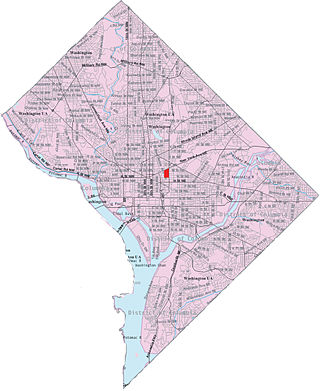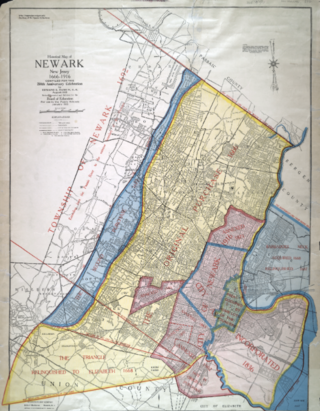
The Ironbound is a neighborhood in the city of Newark in Essex County, in the U.S. state of New Jersey. It is a large working-class multi-ethnic community, covering about 4 square miles (10 km2). Historically, the area was called "Dutch Neck," "Down Neck," or simply "the Neck," for its location by a bend of the Passaic River. Part of Newark's East Ward, the Ironbound is directly east of Newark Penn Station and Downtown Newark, and south and west of the river. The neighborhood is connected by the Jackson Street Bridge over the river to Harrison and Kearny.

University Heights is a neighborhood in Newark in Essex County, in the U.S. state of New Jersey. It is so named because of the four academic institutions located within its boundaries: Rutgers University, New Jersey Institute of Technology (NJIT), New Jersey Medical School (Rutgers) and Essex County College. In total, the schools enroll approximately 30,000 degree-seeking students.

Downtown Newark is the central business district of Newark in Essex County, in the U.S. state of New Jersey.

Sursum Corda is a small neighborhood located in Washington, D.C., Located in Northeast and Northwest. Bounded by New Jersey Avenue NW, New York Avenue NW & NE, Massachusetts Avenue NW & NE, First Street NW, N Street NW, Florida Avenue NE, Delaware Avenue NE, 2nd Street NE, NoMa-Gallaudet-New York Avenue Metro Train Tracks,

Newark has long been the largest city in New Jersey. Founded in 1666, it greatly expanded during the Industrial Revolution, becoming the commercial and cultural hub of the region. Its population grew with various waves of migration in the mid 19th century, peaking in 1950. It suffered greatly during the era of urban decline and suburbanization in the late 20th century. Since the millennium it has benefited from interest and re-investment in America's cities, recording population growth in the 2010 and 2020 censuses.

The New York City Housing Authority (NYCHA) is a public development corporation which provides public housing in New York City, and is the largest public housing authority in North America. Created in 1934 as the first agency of its kind in the United States, it aims to provide decent, affordable housing for low- and moderate-income New Yorkers throughout the five boroughs of New York City. NYCHA also administers a citywide Section 8 Leased Housing Program in rental apartments. NYCHA developments include single and double family houses, apartment units, singular floors, and shared small building units, and commonly have large income disparities with their respective surrounding neighborhood or community. These developments, particularly those including large-scale apartment buildings, are often referred to in popular culture as "projects."
New Community Corporation (NCC) is a not-for-profit community development corporation based in Newark, New Jersey. NCC focuses on community organizing, provision of a variety of community-enhancing services, and resident participation in agency operation. Early prototypes of the community action movement included local housing and service agencies started by the Ford Foundation Gray Areas Initiative and the United States Office of Economic Opportunity, and both federal and private Mobilization for Youth in New York City.

Ivy Hill is a neighborhood of Newark, Essex County, in the U.S. state of New Jersey. It is a diverse neighborhood in the city's West Ward bordering South Orange, Maplewood and Irvington.There are many well kept homes and streets in the neighborhood. The Ivy Hill neighborhood is often considered a section of the Vailsburg area.
HOPE VI is a program of the United States Department of Housing and Urban Development. It is intended to revitalize the most distressed public housing projects in the United States into mixed-income developments. Its philosophy is largely based on New Urbanism and the concept of defensible space.
Dayton is a neighborhood within the city of Newark in Essex County, in the U.S. state of New Jersey. It is part of the city's south ward

Lincoln Park is a city square and neighborhood, also known as "the Coast," in Newark, Essex County, New Jersey, United States. It is bounded by the Springfield/Belmont, South Broad Valley, South Ironbound and Downtown neighborhoods. It is bounded by Martin Luther King Jr. Blvd. to the west, West Kinney St. to the north, the McCarter Highway to the east and South St., Pennsylvania Avenue, Lincoln Park and Clinton Avenue to the south. Part of the neighborhood is a historic district listed on the New Jersey Register of Historic Places and the National Register of Historic Places. Lincoln Park as a street turns into Clinton Avenue toward the south and north edge of the park.

Washington Highlands is a residential neighborhood in Southeast Washington, D.C., in the United States. It lies within Ward 8. Bounded by Oxon Run Park(Oxon-Run Trail)SE, Livingston Road SE, South Capitol Street SE, Southern Avenue SE, Valley Avenue SE, and 13th Street SE.

The Roanoke Apartments, also known as the Terrace Apartments, is an apartment complex listed on the National Register of Historic Places located at 1402 Maiden Lane in the Raleigh Court neighborhood of the independent city of Roanoke, Virginia, U.S.A. Designed by James F. Mactier and constructed by Paul A. Wood, the complex features seven separate buildings, each with brick facades, and is Roanoke's best example of the streamline moderne style developed in the early 1950s. Today the complex is noted for its ethnic diversity with its residents representing a wide array of religious and ethnic groups.

One Theater Square is a mixed-use building in Newark, New Jersey. It is located across from Military Park and the New Jersey Performing Arts Center, which inspired its name. Completed in 2018, it includes the first newly-constructed high rise apartment building to be built in the city in more than fifty years. It was designed by BLT Architects.

Weequahic is a neighborhood in the city of Newark in Essex County, in the U.S. state of New Jersey. Part of the South Ward, it is separated from Clinton Hill by Hawthorne Avenue on the north, and bordered by the township of Irvington on the west, Newark Liberty International Airport and Dayton on the east, and Hillside Township and the city of Elizabeth on the south. There are many well maintained homes and streets. Part of the Weequahic neighborhood has been designated a historic district; major streets are Lyons Avenue, Bergen Street, and Chancellor Avenue. Newark Beth Israel Medical Center is a major long-time institution in the neighborhood.
In 1994 the Atlanta Housing Authority, encouraged by the federal HOPE VI program, embarked on a policy created for the purpose of comprehensive revitalization of severely distressed public housing developments. These distressed public housing properties were replaced by mixed-income communities.

50 Rector Park is an apartment building in Newark, New Jersey, the first market rate residential high-rise to be newly built in the city since 1962. Originally called One Riverview and later 1 Rector Street, there was a groundbreaking in 2013, but construction did not begin at the site until the spring of 2017. It was topped out in April 2018 and opened June 2019.

Halsey Street is a north-south street in Downtown Newark, New Jersey, which runs between and parallel to Broad Street and Washington Street. Halsey Street passes through the four of city's historic districts: James Street Commons at the north, the abutting Military Park and Four Corners and, after a two block break, Lincoln Park at the south.
The Seth Boyden Terrace, named after Seth Boyden, was a former public housing complex in the South Ward of Newark, New Jersey.















